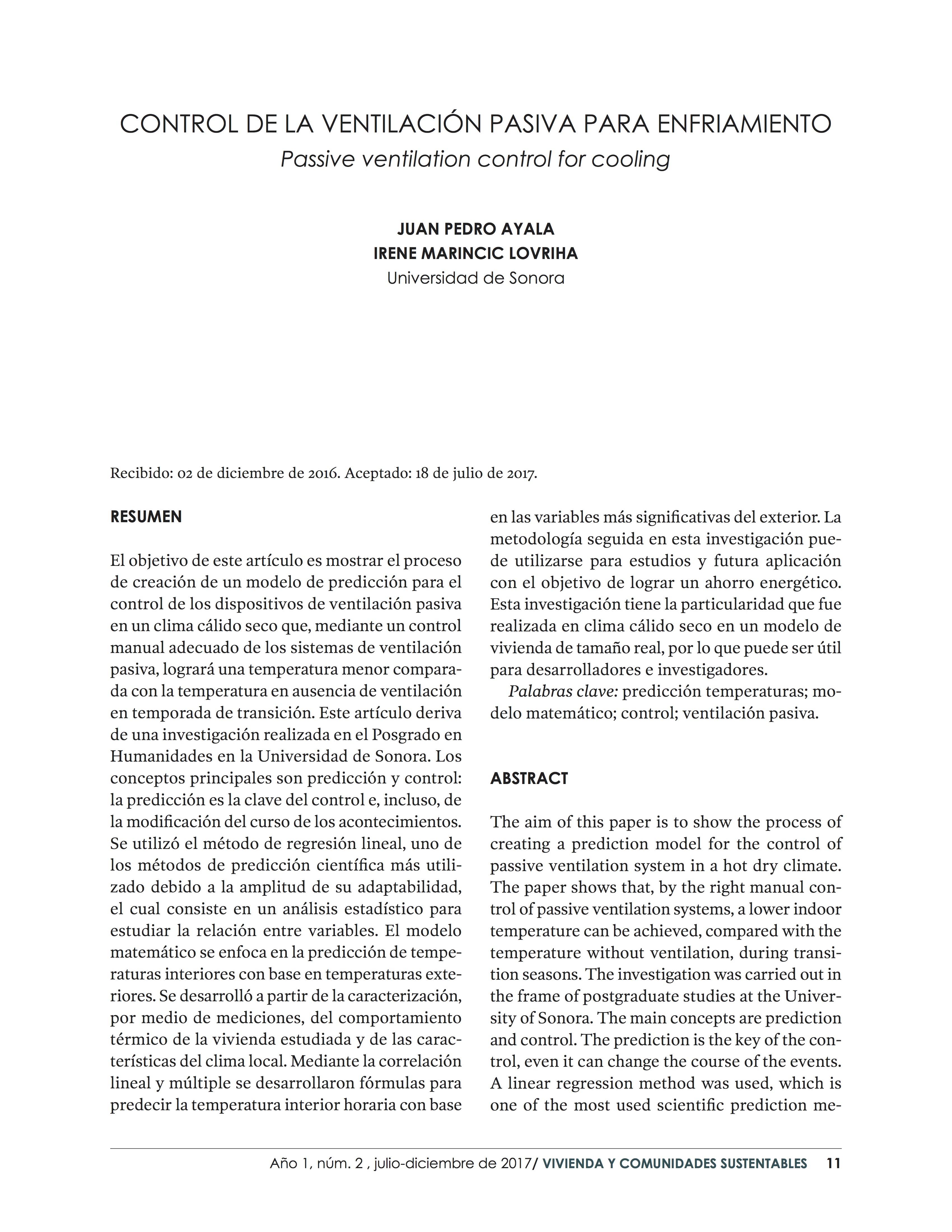Passive ventilation control for cooling
DOI:
https://doi.org/10.32870/rvcs.v0i2.38Keywords:
temperature prediction, mathematical model, control, passive ventilationAbstract
The aim of this paper is to show the process of creating a prediction model for the control of passive ventilation system in a hot dry climate. The paper shows that, by the right manual control of passive ventilation systems, a lower indoor temperature can be achieved, compared with the temperature without ventilation, during transition seasons. The investigation was carried out in the frame of postgraduate studies at the University of Sonora. The main concepts are prediction and control. The prediction is the key of the control, even it can change the course of the events. A linear regression method was used, which is one of the most used scientific prediction methods due to its adaptability. This method is a statistical analysis for estimating the relationships among variables. The mathematical model focuses on predicting indoor temperatures, based on outdoor temperatures. It was developed starting from the characterization, by measurements, of the thermal behavior of the dwelling studied, and of the local climate characteristics. By linear and multiple correlation, formulas were developed to predict the hourly interior temperature, based on the most relevant exterior variables. The metho- dology followed in this research can be used for other studies and future applications with energy savings purposes. This research has the particularity that was carried out in a hot dry climate and in a full- scale housing prototype. Because of this, it can be useful for housing developers and researchers.Metrics
References
Alfaro Gutiérrez, Rodrigo Rafael (2005). Evaluación práctica del aislamiento acústico de ductos utilizados para la ventilación forzada de viviendas. Tesis de licenciatura. Valdivia: Universidad Austral de Chile. https://doi.org/10.4206/sint.tecnol.2005.v2n2-07
Breesch, Hilde; De Meester, Bram; Klein, Ralf y Versele, Alexis (2011). "Evaluation of Passive Cooling in Low Energy Police O ce. PLEA 2011 - 27th Conference on Passive and Low Energy Architecture". Lovaina la Nueva, 13-15 de julio, pp. 751-756.
Bunge, Mario (1995). La ciencia, su método y su filo- sofía. México: Grupo Patria Cultural.
Dias Bordalo Junior, Hamilton (2010). Estrategias de ventilación natural en edificios para la mejora de la eficiencia energética. Tesina de maestría. Bar- celona: Universitat Politècnica de Catalunya.
Giménez Arias, Jorge Enrique (2011). Ökohaus, viviendas en el jardín. Tesina de maestría. Barcelo- na: Universitat Politècnica de Catalunya.
Givoni, B. y Vecchia, F. (2001). "Predicting Ther- mal Performance of Occupied Houses". The 18th International Conference on Passive and Low Energy Architecture. Florianópolis, 7-9 de noviembre.
Inzunza, Juan Carlos (2005). "Clasificación de los climas de Köppen". Ciencia... Ahora, núm. 15, año 8, pp. 1-14.
Krüger, Eduardo y Givoni, Baruch (2009). "Ther- mal Monitoring and Indoor Temperature Pre- dictions in a Passive Solar Building in an Arid Environment". Proceedings of ISES World Congress 2007, (vol. I - vol. V), pp. 432-435.
https://doi.org/10.1007/978-3-540-75997-3_76
Marincic, I.; Ochoa, J. M.; Alpuche, M.G. y Gó- mez-Azpeitia, G. (2009). "Adaptive Thermal Comfort in Warm Dry Climate: Economical Dwellings in Mexico". PLEA2009 - 26th Conference on Passive and Low Energy Architecture. Quebec, 22-24 de junio.
Rodríguez Jaume, María José y Morar Catala, Rafael (2002). Estadística informática: casos y ejemplos con el SPSS. Alicante: Universidad de Alicante.

Downloads
Published
How to Cite
Issue
Section
License
Copyright (c) 2017 Vivienda y Comunidades Sustentables

This work is licensed under a Creative Commons Attribution-NonCommercial-NoDerivatives 4.0 International License.
The authors who publish in this journal accept the following conditions:
In accordance with the copyright legislation, Sustainable Housing and Communities recognizes and respects the moral right of the authors, as well as the ownership of the patrimonial right, which will be transferred to the University of Guadalajara for its dissemination in open access. Sustainable Housing and Communities does not charge authors for submitting and processing articles for publication. Authors may make other independent and additional contractual agreements for the non-exclusive distribution of the version of the article published in Sustainable Housing and Communities (for example, include it in an institutional repository or publish it in a book) as long as they clearly indicate that the work is published for the first time in Sustainable Housing and Communities.





